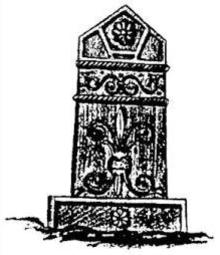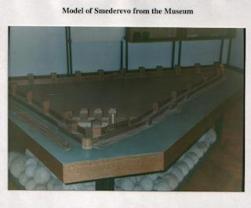The History of the Order of the Fleur-de-Lys
The present Order is actually an amalgamation of three Orders (The Order of the Lys, the Order of the Crescent and the Order of St. James of Altopascio).
Ordre du Lys (Order of the Lily)
The avowed purpose of the Order was the re-establishment of the Judaic-Christian Kingdom of Jerusalem and, until the 1995 change to the constitution, this was still stated as the prime purpose of the Order. The Sovereign of the Order was in theory the Reigning King of Jerusalem of the Anjou dynasty. With the establishment of the State of Israel however, we have amended this and merely put this in a preamble to the new constitution as the reason for the Order’s founding.
To understand how the Order was founded and its relationship with the Orders of St. James of Altopascio and the Crescent it is necessary to understand the historical conditions at the time of and prior to the Order’s founding.
In 1307 the Order of the Temple was officially closed by the Avignon Pope, Clement V under the Orders of Philippe IV of France and Philippe arrested all members in France and sequestrated their goods. Scotland however was under excommunication from this same Pope, and was more than happy to give refuge to Templars. Many Templars would have had families or relatives in Scotland and it is likely that in return for safe haven that the Templars would have aided the Scots King in his fight against the English and it is possible that they took part in the Battle of Bannockburn in 1314.
Certainly on 24th. October 1358, Alexander Montgomery, 2nd. son of Alexander de Montgomery of Egglesham received a safe conduct from the English to ‘Go abroad’ with a party of 60 mounted Templar Knights and Men-at-Arms. (1) It seems that they went to join their brethren of the Order of the Sword in Lithuania. The Order of the Sword was originally a daughter Order of the Templars. It is not unreasonable to claim however that when Rene founded his Crusading Orders of the Lys and the Crescent that he considered them a continuation of the Templars.

The Order was given its first Document on 30th. August 1439 by Rene d’Anjou, who was at that time King of Jerusalem, Naples and Hungary, Duc d’Anjou, de Bar et Lorraine (2). Rene had married the heiress to the Duchy of Lorraine, but when he attempted to claim it on behalf of his wife, his claim was contested by Anthony de Vaudemont, who defeated Rene at the battle of Bulgneville on 2nd. July 1431. Rene was then handed over to the Duke of Burgundy for a large ransom. He was released on parole and eventually had to cede land for his ransom. Whilst a prisoner, he inherited Anjou from his elder brother and Naples and Sicily from his sister-in-law, Queen Joan. After his release from prison he ruled as King of Naples until 1442 and it was during this period that he constituted the Order, from what was originally a Company of Scottish Gentlemen at Arms in the Army of the King of France.
In the 1420s, The Earls of Buchan, Douglas, Murray and Mar had led some 6,000 Scottish Knights and Men-at-Arms to France to help the King of France against the English. They were under the command of the Scottish Constable Sir John Stewart of Darnley, though some authorities dispute this and state that he was a different Sir John Stewart, and the later Constable of the King of France’s Scottish Division, Sir John de Montgomery, Laird of Giffen and Seigneur d’Azay-le-Rideau. They participated at the siege of Orleans alongside Rene d’Anjou and Joan of Arc (3). (See also Revue Cantonale de Livarot, 3e trimestre 1987, also History of the Art of War in the Middle Ages by Sir Charles Oman, volume 2, 1278 – 1485). In 1424 at the bloody battle of Verneuil large numbers of the Scots contingent were killed including Sir John Stewart, the Earls of Buchan, Douglas, Murray & Mar and Sir William Seton. Sir John de Montgomery, the only remaining commander drew off the remaining Scots in good order in a fighting rearguard action.
In 1425 Charles VII of France created an elite bodyguard of Scots consisting of two sub-divisions: a) ‘Garde du Roi’ – b) ‘Garde de Corps du Roi'(4). However there were still a great number of Scots gentlemen who could not be accommodated in the Scots guards, as these two divisions were collectively known, and this group formed themselves into what amounted to an independent mercenary company called ‘Compagnie des gentilhommes Ecossais’ and wore a Fleur de Lys on their left breast to show that they owed allegiance to the King of France.
Although the overall contingent was known by this name it was formed from five individual companies. The first company under the direct command of John de Montgomery consisted of 72 men-at-arms and 27 archers. The second company under Rankin Kennedy consisted of 47 men-at-arms and 3 guisarmers. The third company under David Haliday consisited of 21 men-at-arms, 59 archers and 7 guisarmers.
The fourth company under Alan Forley was composed of 35 men-at-arm and 8 guisarmers and the fifth company under Alexander Seton consisted of 11 men-at-arm and and 12 archers these latter from the bodyguard of the King of France as per letter dated 7th January 1435. This contingent helped Rene d’Anjou to regain the Kingdom of Naples and for this, were granted recognition in the form of a Document by Rene in which Rene used the term ‘Ordre du Lys’.
The Order’s badge now became a cross fleury outlined in gold or yellow with a fleur de lys at its centre (See: The Constitution of the Order). The obverse of Rene’s Great Seal on the rear page of the Constitution of the Order shows the original cross fleury of the Order, which is slightly different from its present day descendent being in fact a cross fleurette. Rene’s private Chapel in the Castle in Angers became the chapel of the Order and you can still see the cross fleurys in a circle around the chapel though sadly the gold leaf has faded.
The Scots Mercenary Companies were not always welcomed by the French themselves. It is recorded that a particular French nobleman tried to put down a Montgomery member of the Order on the grounds that he, the noblemen, fought for honour whilst the Order fought for money. ‘Yes’ replied Montgomery ‘We all fight to gain that which we don’t have’. One of the nicer ‘put downs’ of history I’ve always thought.
In his fight to gain the Kingdom of Naples, Rene had been supported by Cosimo de Medici the elder, whose descendants became Dukes of Florence and later Grand Dukes of Tuscany as well as John de Montgomery, mentioned above, one of the great military leaders of his day. (See “Revue Cantonale” de Livarot, op. cit). These three became the ‘Founders’ of the Order and the Sovereign Grand Commandership of the Order is restricted to the descendants of those three plus the Sforza family. Sforza had later commanded Rene’s forces, which had included a large number of Scots mercenaries, against the Aragonese contender for the throne of Naples. Alfonso’s forces were however successful and in 1442 Alfonso of Aragon was proclaimed King of Naples and Sicily. Apart from the Sforzas, the latest Constitution of the Order added two more families, who qualified by collateral marriage, to the list of Families entitled to become Sovereign Grand Commanders. The reason for calling the Order, the ‘Order of the Lily’ becomes immediately apparent, when one considers that the Fleur-de-Lys was the emblem of the Montgomerys in Scotland, Rene as a member of the French Royal House had the Fleur-de-Lys as part of his Coat of Arms and another form of the Fleur-de-Lys was the emblem of Florence of the Medicis.
In 1445 Charles VII created what amounted to a standing Army of 15 ‘Compagnies d’ordannance’ of 600 men each, amongst which, was the ‘Compagnie des Gendarmes Ecossois’. This company enjoyed pride of place in the French Army with its commander being given the title ‘Premier Master of Camp of French Cavalry’ and the company having the right to pass first in revue (5).
One therefore had two groups of Scots with slightly different allegiances. On the one hand, the ‘Scots guards and Compagnie des Gendarmes Ecossois’, who owed allegiance to the King and on the other the ‘Ordre du Lys and Compagnie des gentilhommes Ecossais’, who owed allegiance to the house of Anjou. I suspect however that the Scots Mercenary Companies were not particularly worried about their theoretical allegiance but would take service with whoever was willing to pay them and in reality the oath that they took was to their company commander and the Sovereign head of the Order. In 1445 John de Montgomery was killed and Rene appointed Francisco Sforza, to be the Commander of the remainder of the Compagnie, who at that time were acting as mercenaries for Sforza, now Duke of Milan with money provided by Cosimo de Medici. At this time too the enmity between the two branches of the French royal family started to turn murderous. Later, because of the death of Rene’s two sons, probably from poisoning by the House of Valois, Fco. Sforza would become head of the Order as well, until Rene’s grandson, Rene de Lorraine, could take over. Fco. had started life as head of a mercenary company and it is likely that the two groups either merged or at least worked together under one leader.

In 1444 members of the Order and the Company, had fought in what today we call Bosnia-Herzegovina, but which at that time was part of the Serbian Byzantine Empire and which was in the forefront of the fight against Islam. The Order succeeded in returning George Brankovich to the throne of Serbia and this event is still marked today by the Fleur-de-Lys Monument (Called the Fleur-de-Lys Obelisk) at Blatsha (See photographs & ref. note 6).
George Brankovich had built himself a Capital City at Smederevo, based upon Byzantium. Originally a compound that contained only the Royal Palace it was later enlarged to house a complete town (See photograph of model in the Museum at Smederevo. The inner part is the original palace complex). Built on the Byzantium style with great square towers overlooking the Danube, it was barely completed when overrun by the Turks.
The Order eventually managed to restore George Brankovich to the throne and the then Grand Commander announced the return of Brankovich to the throne from the steps of the palace in Smederevo. They also started to rebuild the defensive works and one can see two of the towers which were completed after the return of Brankovich are modelled on the Crusader/Templar castles, being round octagonal in shape, the better to withstand siege engines ( See photograph of model).
In tribute to the work of the Order the seal of Brankovich after his return bears only the symbol of the Fleur-de-Lys on its reverse (See Photograph), whilst as previously his seal had shown on the obverse, his coat of arms. The handle of the key of the new citadel was in the form of the roseate cross (See photograph).
In 1448 the Order found itself once again fighting in Serbia or perhaps had simply continued there since 1444. At all events, on 19th October 1448 Janos Hunyadi, Regent of Hungary (Rene was Titular King of Hungary – See appendix in the Constitution – Angevin Dynasty of Hungary), led a European Army against Sultan Murad II. The Army consisted of Hungarians, Wallachians and Knights of the Orders of the Dragon (Hungarian), the Crescent and the Lys. They were defeated at the 2nd. Battle of Kossovo and many knights are slaughtered. Serbians having been forbidden by Brankovich from taking part (He had come to an arrangement with Murad and had married his daughter to the Sultan), joined one or other of the Orders and took part as members of those Orders. A number of Jewish warriors also joined one or other of the Orders, certainly the Lys, and fought or acted as physicians, alongside their Christian brethren. The reasons for this go back to the foundation of the Jewish Princedom in Septimania in the 8th Century. These warriors would have been subjects of the ‘Exilarch of the West’, who opposed Murad II.
Although the battle was lost and the greatest number of Europeans killed until the 1st. World War, Dracula the 17-year-old grandson of the Wallachian Prince Dracul, who had been a hostage of the Turks for 4 years, managed to escape during the battle and assumed the throne of Wallachia. So many knights were killed that it was not possible to identify them all, therefore all were buried with simple stones above them on which were inscribed a sword with either a circle (For members of the Dragon), a crescent (For members of the crescent) or a Fleur de Lys (For members of the Lys).

The stones were still to be seen before the break up of Yugoslavia and a book with drawings of these graves was published in 1890 (7). For that we must be thankful as it is likely that with the troubles in Kossovo these graves may well have been destroyed, however two headstones of members of the Order are standing outside the Ethnic Museum in Belgrade (See photographs).
There appears to be a muddle about the gravestones of the members of the Orders and the Stecci in Bosnia. Some authorities have imputed the continuation of pagan or Bogomil traditions to these. There may well be some stones of which this is true but they should not be mistaken for the gravestones of the Orders (8). Indeed Asboth Janos specifically says that these are the graves of noblemen and even princes.
Interestingly enough a Serbian book called “Symbols of Serbian Statehood” by Zlatko V. Mladichevich, published in 1994 (Written in Serbo-Croat, but kindly translated by Gradimir Popovic KGL.) maintains that symbol of the Fleur-de-Lys did not come to Serbia with Helen d’Anjou (who married King Urosh and died in 1314 ) and originated not with the Anjous’, but in Serbia about 100 years previously and that Charles d’Anjou had brought it back with him to France.
Certainly there are Murals on the walls of a Monastery in Serbia with warriors wearing the fleur-de-lys on their armour. It is doubtful however that they are the originators of the present Order and the French Coat of Arms (Azure semi-de-lys Or) was already being used in 1137 by Louis VII and John de Montgomery’s seal (Azure a fleur de lys Or) was being used as early as 1170.


All of the families who fought with the Order of the Fleur-de-Lys added two gold fleur-de-lys to their coats of Arms in the topmost part of the shield (In chief – heraldically). However if the field of the shield was already gold or yellow this was obviously not possible and at least one family, that of the Dobrijevic, added the fleur de lis to their crest. His Grace, Bishop Irinej, The Serbian Orthodox Bishop of Australia and New Zealand is a descendant of that family and holds the rank of a Chaplain Companion of the Order.

The Dobrijevic Coat of Arms
Since this history first appeared on the internet the order has been contacted by many people claiming to be descended from either Serbian or Bosnian families who served with the Order. Indeed some Bosnians maintain that it was they, who thinking that the battle had been won, rode to Vienna to inform them of a great victory. Alas the Turks regrouped after their initial defeat and whilst the European forces were disorganised proceeded to roll them up and slaughter them. Certainly some Bosnian families proudly use the fleur de lis.

